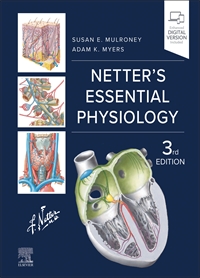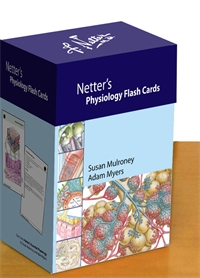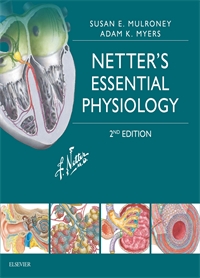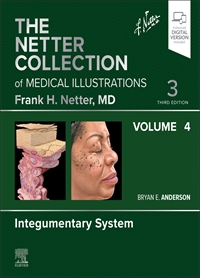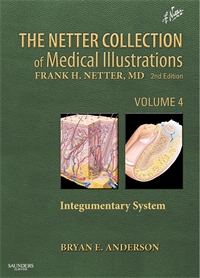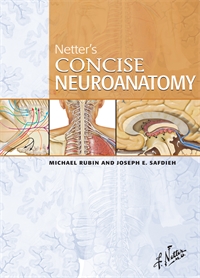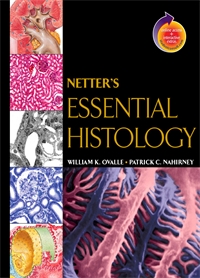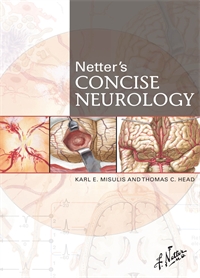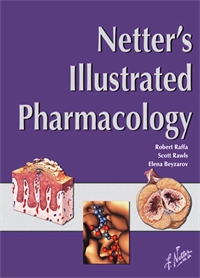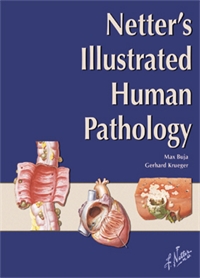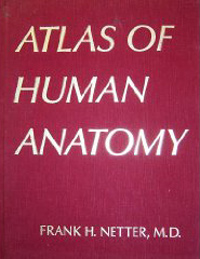Physiology - Mulroney 1E
Author: Susan E. Mulroney, Adam K. Myers
ISBN: 9781416041962
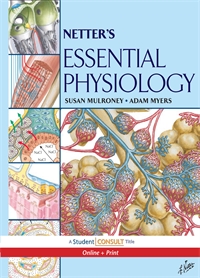
Cell Physiology, Fluid Homeostasis, and Membrane Transport
- Page 4: Cell in the Primordial Sea
- Page 5: Buffering the External Environment
- Page 6: The Eukaryotic Plasma Membrane
- Page 7: Body Fluid Compartments
- Page 7: Total Body Water as Function of Body Weight
- Page 8: Electrolyte Concentration in Extracellular and Intracellular Fluid
- Page 9: Osmosis and Osmotic Pressure
- Page 9: Starling Forces Across the Capillary
- Page 10: Effect of Adding Solutes to the Extracellular Fluid on Compartment Size
- Page 11: Net Fluid Balance
- Page 12: Measurement of Fluid Compartment Size
- Page 14: Diffusion Through a Semipermeable Membrane
- Page 14: Passive Membrane Transport
- Page 15: Primary (1°) Active Transport
- Page 16: Secondary (2°) Active Transport
- Page 16: Vesicular Transport through the Membrane
- Page 17: Water Channels
- Page 18: Ca2+-Calmodulin Signal Transduction
- Page 19: G Protein–Coupled Receptors
- Page 19: Nuclear Protein Receptors
- Page 19: Simple and Complex Transduction Systems
- Page 20: Cystic Fibrosis
The Nervous System and Muscle
- Page 26: Membrane Potential of a Hypothetical Cell
- Page 27: The Resting Membrane Potential
- Page 29: Action Potential
- Page 30: Neurons
- Page 31: Axonal Conduction
- Page 32: Multiple Sclerosis
- Page 34: Morphology of Synapses
- Page 35: Chemical Synaptic Transmission
- Page 36: Temporal and Spatial Summation
- Page 37: Synaptic Inhibitory Mechanisms
- Page 38: Structure of the Neuromuscular Junction
- Page 39: Clinical Manifestations of Myasthenia Gravis
- Page 40: Organization of Skeletal Muscle
- Page 41: Sarcoplasmic Reticulum
- Page 42: Excitation-Contraction Coupling
- Page 43: Muscle Contraction and Relaxation
- Page 44: Biochemical Mechanics of Muscle Contraction
- Page 45: Grading of Muscle Tension and Length-Tension Relationship
- Page 47: Smooth Muscle Structure
- Page 47: Excitation-Contraction Coupling of Smooth Muscle
- Page 48: Schema of Structure of Cardiac Muscle
- Page 50: Major Parts of the Central Nervous System and the Vertebral Column
- Page 50: Brain Ventricles and CSF Composition
- Page 51: Circulation of CSF
- Page 52: Cerebral Cortex: Association Pathways and Localization of Function
- Page 53: Organization of the Brain: Surface Anatomy of the Cerebral Cortex
- Page 54: The Limbic System
- Page 55: Spinal Cord and Ventral Rami In Situ
- Page 56: Spinal Membranes and Nerve Roots
- Page 57: Somatic Component of the Peripheral Nervous System
- Page 58: Spinal Cord Injury
- Page 60: Skin and Cutaneous Receptors
- Page 61: Dermatomes
- Page 62: Pacinian Corpuscle
- Page 63: Somesthetic System of the Body
- Page 64: Somesthetic System of the Head
- Page 65: Visual Receptors
- Page 66: Retinogeniculostriate Visual Pathway
- Page 67: Peripheral Pathways for Sound Reception
- Page 68: Cochlear Receptors
- Page 69: Auditory Pathways
- Page 70: Vestibular Receptors
- Page 71: Vestibulospinal Tracts
- Page 72: Taste Receptors
- Page 73: Taste Pathways
- Page 74: Olfactory Receptors
- Page 75: Olfactory Pathway
- Page 78: Muscle and Joint Receptors
- Page 79: Proprioception: Spinal Effector Mechanisms
- Page 80: Proprioceptive Reflex Control of Muscle Tension
- Page 81: Spinal Reflex Pathways for Stretch, Tendon Organ, and Flexor Withdrawal
- Page 82: Corticospinal Tracts
- Page 83: Cerebellar Afferent Pathways and Functional Subdivisions of Cerebellum
- Page 84: Cerebellar Efferent Pathways
- Page 85: Cerebellar Neuronal Circuitry
- Page 86: Parkinson's Disease
- Page 88: Cholinergic and Adrenergic Synapses: Schema
- Page 89: Autonomic Nervous System: Sympathetic Division
- Page 90: Autonomic Nervous System: Parasympathetic Division
- Page 92: Pheochromocytoma
Cardiovascular Physiology
- Page 98: Cardiac Structural Changes in Disease
- Page 99: General Scheme of the Circulation
- Page 100: Structure of Heart
- Page 100: Conduction System of the Heart
- Page 102: Atrioventricular Block
- Page 103: Electrical Activity of the Heart
- Page 104: Cardiac Depolarization and Repolarization Part 1
- Page 105: Cardiac Depolarization and Repolarization Part 2
- Page 106: Cardiac Depolarization and Repolarization Part 3
- Page 108: The Arterial Pressure Wave
- Page 109: Pulmonary Artery Catheterization
- Page 110: Pulse Pressure through the Circulation
- Page 110: Poiseuille's Law
- Page 111: Relationship Between Velocity of Blood Flow and Cross-Sectional Area
- Page 111: Laminar and Turbulent Flow
- Page 112: Aortic Aneurysm
- Page 114: The Cardiac Cycle
- Page 116: Autonomic Nervous System and Arterial Baroreceptor Reflexes
- Page 118: The Frank–Starling Relationship
- Page 118: Effect of Heart Rate on Force of Contraction (Treppe or Staircase Effect)
- Page 119: Force–Velocity Relationship in Cardiac Muscle
- Page 120: Echocardiography
- Page 121: Ventricular Pressure-Volume Loop
- Page 123: Cardiac Function and Vascular Function Curves
- Page 126: The Vascular Wall
- Page 126: Components of the Microcirculation
- Page 127: The Lymphatic Circulation
- Page 128: Control of the Arteriolar Tone
- Page 130: Local Regulation of Blood Flow
- Page 132: Monitoring of Blood Pressure
- Page 133: Long-Term Response to Changes in Blood Volume and Pressure
- Page 135: Circulation to Special Regions
- Page 136: Coronary Circulation
- Page 138: Myocardial Ischemia
- Page 139: Circulatory Response to Exercise
- Page 140: Fetal and Neonatal Circulation
Respiratory Physiology
- Page 147: Pulmonary and Systemic Circulations
- Page 148: Pulmonary Vascular Resistance
- Page 149: Gross Anatomy of the Lung
- Page 150: Structure of the Trachea and Major Bronchi
- Page 151: Intrapulmonary Airways
- Page 152: Ultrastructure of Tracheal, Bronchial, and Bronchiolar Epithelium
- Page 153: Intrapulmonary Blood Circulation
- Page 154: Ultrastructure of Pulmonary Alveoli and Capillaries
- Page 155: The Spirometer
- Page 155: Measurement of Lung Volumes and Capacities by Spirometry
- Page 158: Partial Pressures of Oxygen and Carbon Dioxide in Blood and Alveolar Air
- Page 159: O2 and CO2 Exchange
- Page 160: Distribution of Pulmonary Blood Flow
- Page 162: Ventilation–Perfusion (Va-Qc) Relationships
- Page 164: Respiratory Muscles
- Page 165: Forces During Quiet Breathing
- Page 166: Elastic Properties of Respiratory System: Lung and Chest Wall
- Page 167: Pneumothorax
- Page 168: Measurement of Elastic Properties of Lung
- Page 169: Compliance in Pulmonary Diseases
- Page 170: Compliance and Surface Forces of the Lung
- Page 172: Respiratory Distress Syndrome of the Newborn
- Page 173: Flow
- Page 174: Expiratory Flow-Volume Relationships
- Page 175: Pulmonary Function in Obstructive Lung Disease
- Page 176: Pulmonary Function in Restrictive Lung Disease
- Page 177: Pulmonary Function Tests
- Page 178: Pulmonary Function Tests
- Page 180: Oxygen Transport
- Page 181: Anemia
- Page 182: Oxyhemoglobin Dissociation Curves
- Page 183: Carbon Dioxide Transport
- Page 184: Carbon Monoxide Poisoning
- Page 184: Sickled Red Blood Cells
- Page 185: Role of Lungs and Kidneys in Acid–Base Balance
- Page 187: Sleep Apnea
- Page 188: Respiratory Control in Chronic Obstructive Pulmonary Disease
- Page 189: Control of Respiration
- Page 190: Respiratory Response to Exercise
- Page 191: Acute Altitude Sickness
Renal Physiology
- Page 198: Anatomy of the Kidney
- Page 199: Nephron Structure
- Page 201: Glomerulonephritis
- Page 202: Anatomy of the Glomerulus
- Page 203: Renal Handling of Para-Amino Hippurate (PAH)
- Page 204: Glomerular Filtration
- Page 206: Renal Clearance Principle
- Page 210: Nephron Sites of Sodium Reabsorption
- Page 212: Renal Handling of Glucose
- Page 213: Renal HCO3– Reabsorption
- Page 214: Renal Potassium Handling
- Page 215: Renal Calcium and Phosphate Handling
- Page 216: Kidney Stones (Renal Calculi)
- Page 220: Medullary Interstitial and Tubular Concentration Gradients
- Page 222: The Renal Response to ADH Secretion
- Page 223: Dilution of the Urine
- Page 224: Chronic Pyelonephritis
- Page 232: General Scheme for Eliminating Excess Acid
- Page 234: Renal Handling of Acid Excretion
- Page 236: Role of the Lungs and Kidneys in the Regulation of Acid–Base Balance
- Page 237: Plasma Anion Gap
Gastrointestinal Physiology
- Page 244: Overview of the Gastrointestinal Tract
- Page 245: Musculature of the Stomach
- Page 246: The Enteric Nervous System
- Page 247: The Portal System
- Page 248: Thirst
- Page 249: Appetite and Hunger
- Page 250: Fluid Shifts through the GI Tract
- Page 254: Regulation of Enteric Nervous System by Autonomic Nervous System
- Page 255: Local Control of Motility
- Page 256: Slow Waves
- Page 257: Bariatric Surgery
- Page 259: Lower Esophageal Sphincter
- Page 260: Gastric Motility
- Page 261: Peristalsis and Segmentation
- Page 262: Structure of the Gallbladder
- Page 263: Motility in the Colon
- Page 264: Autonomic Innervation of the Colon
- Page 266: Defecation
- Page 267: Vomiting
- Page 267: Effect of Major GI Hormones on GI Motility
- Page 268: Cholera
- Page 269: Smooth Muscle Disorders: Achalasia and Hirschprung's Disease
- Page 272: Major Secretions into the GI Tract
- Page 273: Salivary Gland Structure
- Page 274: Salivary Acinar Cells
- Page 275: Digestion in the Stomach
- Page 276: Protection of Gastric Mucosa
- Page 277: Parietal Cell HCl Production
- Page 278: Signal Transduction Mechanisms Regulating HCl Secretion
- Page 279: Ulcers
- Page 280: Crypts of Lieberkühn and Cell Types
- Page 281: Structure and Secretion of the Pancreas
- Page 284: Overview of Liver Function
- Page 285: Bilirubin and Jaundice
- Page 286: Structure of the Liver
- Page 288: Portal Hypertension and Esophageal Varices in Obstructive Liver Disease
- Page 292: Small Intestine Surface Area
- Page 293: Carbohydrate Digestion and Absorption
- Page 294: Protein Digestion and Absorption
- Page 296: Lipid Digestion and Absorption
- Page 297: Electrolyte and Fluid Transport
- Page 298: Calcium and Iron Absorption
- Page 299: Vitamin B12 Absorption
- Page 300: Gluten Enteropathy and Celiac Disease
Endocrine Physiology
- Page 308: Organization of the Endocrine System
- Page 309: Overview of Hormone Action
- Page 310: Structure of Hypothalamus and Pituitary
- Page 311: Overview of Anterior Pituitary Function
- Page 313: Negative and Positive Feedback Regulation
- Page 314: Posterior Pituitary Function (ADH)
- Page 315: Posterior Pituitary Function (Oxytocin)
- Page 317: Growth Hormone
- Page 318: Growth Hormone Excess and Deficiency
- Page 319: Prolactin
- Page 322: Thyroid Gland Structure
- Page 322: Structure of T3 and T4
- Page 323: Synthesis and Regulation of Thyroid Hormones
- Page 325: Thyroid Hormone Action
- Page 326: Diseases of Thyroid Function: Hypothyroidism
- Page 327: Diseases of Thyroid Function: Hyperthyroidism
- Page 330: Adrenal Gland Structure
- Page 331: Adrenal Gland Histology
- Page 332: Adrenal Cortical Hormones
- Page 333: Actions of Cortisol
- Page 334: Glucocorticoids as Anti-inflammatory and Immunosuppressive Drugs
- Page 335: Cushing's Syndrome
- Page 336: Actions of Aldosterone
- Page 337: Addison's Disease
- Page 338: Function of the Adrenal Medulla
- Page 340: Structure of the Endocrine Pancreas
- Page 341: Insulin Structure
- Page 342: Insulin Synthesis and Release
- Page 343: Actions of Insulin
- Page 344: Actions of Glucagon
- Page 346: Diabetes Mellitus
- Page 348: Effects of Altered Plasma Calcium Concentration
- Page 349: Parathyroid Hormone Secretion
- Page 350: Parathyroid Hormone and Vitamin D Actions on Plasma Calcium Concentrations
- Page 352: Calcium-Related Pathophysiology: Hyperparathyroidism
- Page 353: Calcium-Related Pathophysiology: Hypoparathyroidism
- Page 354: Calcium-Related Pathophysiology: Vitamine D Deficiency
- Page 356: Gonad and Genital Duct Formation
- Page 357: Differentiation of the External Genitalia
- Page 359: Menstrual Cycle
- Page 360: Ovary, Ova, and Follicles
- Page 361: Abnormal Uterine Bleeding
- Page 362: Hormonal Regulation of the Menstrual Cycle
- Page 363: Fertilization and Implantation
- Page 363: The Testes and Spermatogenesis
- Page 364: Mature Spermatozoon
- Page 365: Klinefelter's Syndrome
- Page 366: Control of Testicular Function

